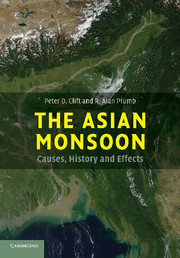Book contents
- Frontmatter
- Contents
- Preface
- Acknowledgements
- 1 The meteorology of monsoons
- 2 Controls on the Asian monsoon over tectonic timescales
- 3 Monsoon evolution on tectonic timescales
- 4 Monsoon evolution on orbital timescales
- 5 Erosional impact of the Asian monsoon
- 6 The Late Holocene monsoon and human society
- References
- Further reading
- Index
- Plate section
1 - The meteorology of monsoons
Published online by Cambridge University Press: 01 September 2009
- Frontmatter
- Contents
- Preface
- Acknowledgements
- 1 The meteorology of monsoons
- 2 Controls on the Asian monsoon over tectonic timescales
- 3 Monsoon evolution on tectonic timescales
- 4 Monsoon evolution on orbital timescales
- 5 Erosional impact of the Asian monsoon
- 6 The Late Holocene monsoon and human society
- References
- Further reading
- Index
- Plate section
Summary
Introduction
Monsoon circulations are major features of the tropical atmosphere, which, primarily through the rainfall associated with them, are of profound importance to a large fraction of the world's population. While there is no universally accepted definition of what constitutes a monsoon, there are some criteria that are widely accepted (see, e.g., the discussions in Ramage (1971), Webster (1987), and Neelin (2007)). Fundamentally, monsoonal climates are found where a tropical continent lies poleward of an equatorial ocean and are characterized by a strong seasonal cycle, with dry winters and very wet summers, and a reversal of wind direction from, in the dry season, the equatorward–easterly flow that is typical of most of the tropics to poleward–westerly flow after monsoon onset. Low-level flow from the ocean imports moisture onto the land to supply the rainfall there (although much of the rainfall within the monsoon system as a whole may actually fall over the neighboring ocean). In fact, in most monsoon systems this inflow includes strong cross-equatorial flow at low levels, from the winter to the summer hemisphere; however, this is not satisfied in all cases (such as the North American monsoon; Neelin (2007)). Indeed, given the differences in detail between different monsoon systems, even though they satisfy the most obvious criteria, it is inevitable that any attempt at definition will be imprecise, and even that classification of some regional meteorological regimes as monsoons may not be universally accepted.
- Type
- Chapter
- Information
- The Asian MonsoonCauses, History and Effects, pp. 1 - 28Publisher: Cambridge University PressPrint publication year: 2008
- 1
- Cited by



